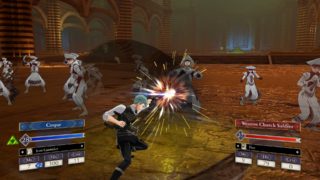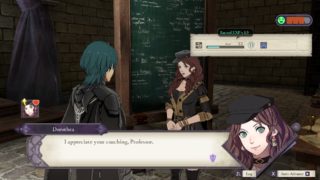Review: Fire Emblem Three Houses is impressive and exhausting
Nintendo’s strategy RPG series expands in every area
- Game Director
- Toshiyuki Kusakihara
- Key Credits
- Genki Yokota (Director (Nintendo)), Kazuma Koda (Environment Art), Takeru Kanazaki (Composer)

The name ‘Three Houses’ is a bold statement of ambition. Three houses, three grand branching storylines, each following the fortunes of a different group of characters.
It’s a vision of great scale and complexity, in which the history and fate of an entire continent unfolds. It’s also a work of immense detail, in those characters, the world, and the battles and systems that surround them. It’s hugely impressive. And just a little exhausting.

As the game’s mysterious young protagonist, you’re installed as a professor in Garreg Mach monastery, the keystone of a church that unifies three volatile countries, and must decide which land’s noble heirs and talented commoners to instruct.
As with many teaching positions, the job comes with a vast array of responsibilities. Not least, at the end of each calendar month you’ll have to take your charges out to complete a mission, in the form of a turn-based battle against nefarious elements threatening the status quo.
More Fire Emblem Engage Guides:
Dining Guide | Spirit of Somniel |How to rewatch cutscenes | amiibo unlocks | Somniel guide | Steel location | Iron location | Gift guide
Between missions, you’ll give lectures, execute side quests, attend seminars or wander the grounds to talk to students and staff, practice fishing or gardening, restock your supplies, fulfil requests and take part in fighting tournaments. You can also ask individual characters to join you in cooking, eating dinner and choir practice, or invite them for a lovely cup of tea.
In battle, while most of the grid-based rules carry over from past Fire Emblem games, additions include the ability to rewind time, enabling you to erase mistakes, as well as battalions that support your units with area based attacks, and passive skills and combat arts that increase each character’s flexibility.
It’s a hefty conglomerate of features, but it all feeds into a single coherent ecosystem. Your monastery activities either develop skills that determine how proficient your students are with each weapon type, or boost support levels which provide bonuses in battle and help in eventually persuading members of other houses to join your team.
Through your lectures, you also get to customise your units, as you take into account your students’ desires and aptitudes and plan their growth through a path of class promotions.
This neat, interlocking structure is fleshed out by some surprisingly effective emotional hooks. The game’s characters initially come across as basic anime archetypes, but as the months pass you get drawn in by their formative backstories, guide them with care or criticism, and watch them mature.
These are individuals who react to each plot development and build bonds with one another, influenced by social status or historic family ties. As the story twists with acts of bravery and betrayal, the relationships add weight to battlefield encounters, especially when you realise that someday you might have to face some of your friends in real combat.
“With all these features and all this narrative texture, perhaps it’s inevitable that they sometimes get in each other’s way.”
With all these features and all this narrative texture, perhaps it’s inevitable that they sometimes get in each other’s way. There’s so much to do that each time the momentum of the plot accelerates, it’s dragged down by an hour or so of housekeeping, bonding activities and lectures.
Setting up a battle can also take an age, if you fully prep your units to suit the scenario, and remember to replenish battalions, repair weapons and so on. It’s a reminder that while all the new ideas do work together, they’re bolted onto an existing formula that functioned perfectly well without them.

Given the minute control you have, it’s also slightly baffling that the game’s challenge is so slight, almost encouraging you to ignore everything but the basics.
Once you start to train and promote your units, your best warriors become difficult to hit or damage, even by big monsters, and with the game’s weak AI you can often simply bait out small groups of foes and harvest them for XP. Combined with some rather plain maps and the small range of classes that are available early on, it stunts your creativity.
Of course, you don’t have to spend hours exploring, or accept every side quest, and there is a Hard difficulty for a more tactically demanding experience (and Nintendo says an “even harder” mode will be added later this year), although you can’t change mid-game.
But skipping monastery tours and relationship building means missing out on new recruits. While in Hard mode, you’ll take even more time setting up battles, grinding levels, and maximising your skills and bonds, so it’s a mixed blessing.
The good news is that some of the stresses are front-loaded and ease off after around 20 hours. Mission design improves, with greater variety and more at stake, and even some moderately testing layouts, while side quests become more enticing as they develop strands of the plot. Exploring the monastery also becomes a speedier affair once you establish a rhythm and aren’t being shuffled around by tiresome fetch quests.
Three Houses is supremely polished, from its visuals, script and voiceovers to its clear objectives and pain-free interface design, and each individual aspect of its broad scope enriches the whole.
But when everything is piled on top of each other, it can’t but strain under the weight. So are all the complex plotlines, extra character customisation, relationship building and new tactical options worth it? Yes. But as with the three houses, it’s an uneasy alliance.
Intelligent Systems has gone big with its latest Fire Emblem and it’s a real achievement, layering up the base game with an absorbing system of customisation options and character development. But at times it feels too big, and will demand plenty of time and patience to see it through.
- An exciting, intricate story with fascinating characters
- A clever, customisable class upgrade system
- Some interesting twists to the classic turn-based format
- So much to do makes for slow progress, especially in the first act
- Some uninspired map designs and lack of challenge

























